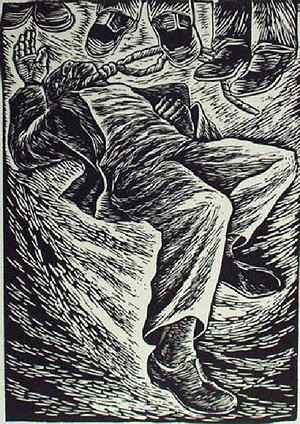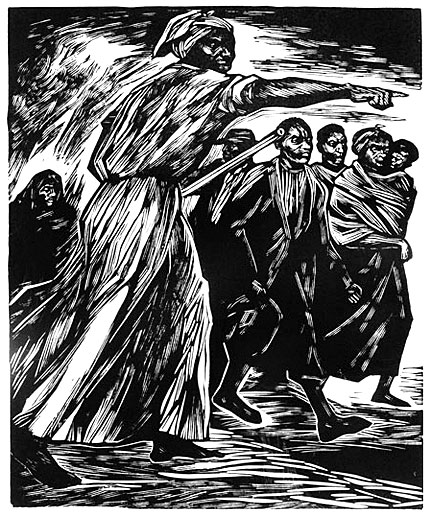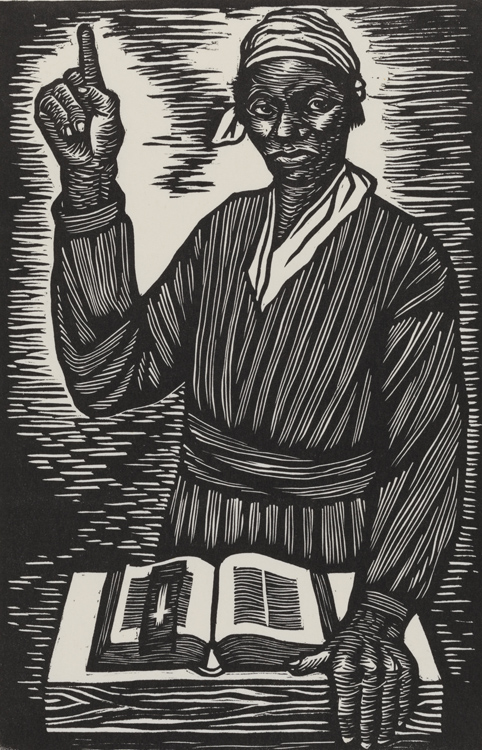It's been a couple of months since I introduced a Printmaker You Should Know, but what can I say, it's been a busy time at the Museum, with plenty of shows warranting discussion. That said, it's high time I got back into it, so today we'll be taking a look at Elizabeth Catlett (1915-2012).
Catlett was raised in Washington, DC. After being denied admission to the Carnegie Institute of Technology on account of her race, Catlett studied at Howard University, graduating in 1935. A few years later, she earned her M.F.A. in sculpture from the University of Iowa. While at Iowa, she studied with painter Grant Wood, best known today for his much-parodied American Gothic. He urged students to experiment with different media while focusing their content on subjects they know best. Catlett responded by dedicating her work to the black experience, particularly that of being a black woman, rendering it through materials as varied as bronze, linocuts, and and wood.
In 1946, Catlett received a grant from the Rosenwald Foundation, and traveled to Mexico. She joined the Taller de Grafica Popular, a notable group of politically-oriented printmakers, and met her future husband, artist Francisco Mora. From 1958 until 1976 she taught at the National School of Fine Art in Mexico City. Due to the leftist leanings of the Taller, Catlett came under the scrutiny of the U.S. Embassy, and was even barred from the United States as an 'undesirable alien,' as they put it. She understandably renounced her U.S. citizenship in 1962, and spent the rest of her life in Mexico.
Stylistically Catlett works in the abstraction of modernism, while her content focuses on the black experience. Her work often highlights the struggle of being black in a predominant white society, but the elegance of her modernist style also infuses her subjects with an inherent dignity. Some of her works feature famous subjects, such as this bust of poet Phillis Wheatley (1753-1784):
Other works highlight more universal themes such as maternity, as is the case with this bronze of a mother and child:
In addition to her sculptural work, Catlett was also a printmaker. Her prints are just as charged as her sculpture in their political and social content, simultaneously celebrating blackness while underscoring injustices and hardships.
I first became familiar with Catlett's work when I saw Sharecropper. The sharecopper's face has been angled above the viewer's eye level, giving her presence a monumentality that evokes a sense of dignity in the face of ongoing struggle.
Want to learn more? You know you do:
http://nmwa.org/explore/artist-profiles/elizabeth-catlett
http://elizabethcatlett.net/
http://www.biography.com/people/elizabeth-catlett-9241731
http://womenartandculture.blogspot.com/2012/05/elizabeth-catlett-sharecropper-1968.html
http://woodblockdreams.blogspot.com/2012/04/elizabeth-catlett-1915-2012.html
http://nydamprintsblackandwhite.blogspot.com/2010/08/survivor-by-elizabeth-catlett.html
https://hbcustory.wordpress.com/2012/04/10/art-as-activism-the-hbcustory-of-howard-alumna-elizabeth-catlett-mora/
http://www.blacdetroit.com/BLAC-Detroit/November-2011/The-Mora-Catlett-Family-Legacy-Lives-On/
 |
| Image courtesy of http://www.biography.com/people/elizabeth-catlett-9241731 |
In 1946, Catlett received a grant from the Rosenwald Foundation, and traveled to Mexico. She joined the Taller de Grafica Popular, a notable group of politically-oriented printmakers, and met her future husband, artist Francisco Mora. From 1958 until 1976 she taught at the National School of Fine Art in Mexico City. Due to the leftist leanings of the Taller, Catlett came under the scrutiny of the U.S. Embassy, and was even barred from the United States as an 'undesirable alien,' as they put it. She understandably renounced her U.S. citizenship in 1962, and spent the rest of her life in Mexico.
Stylistically Catlett works in the abstraction of modernism, while her content focuses on the black experience. Her work often highlights the struggle of being black in a predominant white society, but the elegance of her modernist style also infuses her subjects with an inherent dignity. Some of her works feature famous subjects, such as this bust of poet Phillis Wheatley (1753-1784):
 |
| Phillis Wheatley, 1973, bronze. Image courtesy of http://nmaahc.si.edu/Blog/elizabethcatlett |
Other works highlight more universal themes such as maternity, as is the case with this bronze of a mother and child:
 |
| Seated Mother and Child, 1977, bronze. Image courtesy of http://www.thelmaharrisartgallery.com/artists/sculpture/catlett/works/index.php
Her most significant sculptural work, however, is probably Target, created in 1970 after police forces had shot a Black Panther. This powerful work remains as timely as ever in light of the ongoing police brutality directed toward non-whites.
|
 |
| Target, 1970, bronze. Image courtesy of https://www.pinterest.com/pin/365917538450450311/ |
I first became familiar with Catlett's work when I saw Sharecropper. The sharecopper's face has been angled above the viewer's eye level, giving her presence a monumentality that evokes a sense of dignity in the face of ongoing struggle.
 |
| Sharecropper, 1968, color linocut. Image courtesy of http://womenartandculture.blogspot.com/2012/05/elizabeth-catlett-sharecropper-1968.html |
Other works focus on more appalling subject matter, such as this scene of a lynching:
 |
| And a Special Fear for My Loved Ones, 1946. Image courtesy of http://woodblockdreams.blogspot.com/2012/04/elizabeth-catlett-1915-2012.html
In addition to more anonymous subjects, Catlett also highlighted famous individuals such as Harriet Tubman and Sojourner Truth, from her Negro Woman series.
|
 |
| Harriet, 1946-47, linocut. Image courtesy of http://art-for-a-change.com/blog/2012/04/elizabeth-catlett-dead-at-96.html |
 |
| In Sojourner Truth I Fought for the Right of Women as well as Negroes, 1947, linocut on paper. Image courtesy of http://www.title-magazine.com/2013/02/johnson-on-the-brain/catlett-101/
To me, Catlett's linocuts are the perfect fusion of medium and content. She takes advantage of the medium's angular, bold character to create works that pulse with an inner strength. The people in these impressions have been through hard times, indeed they literally had to be gouged out of the linoleum surface to exist at all, but they are unshakable. They're tough, determined, and dignified, just like Catlett herself. She's definitely a printmaker you should know.
|
 |
| Survivor, 1983, linocut. Image courtesy of http://nydamprintsblackandwhite.blogspot.com/2010/08/survivor-by-elizabeth-catlett.html |
Want to learn more? You know you do:
http://nmwa.org/explore/artist-profiles/elizabeth-catlett
http://elizabethcatlett.net/
http://www.biography.com/people/elizabeth-catlett-9241731
http://womenartandculture.blogspot.com/2012/05/elizabeth-catlett-sharecropper-1968.html
http://woodblockdreams.blogspot.com/2012/04/elizabeth-catlett-1915-2012.html
http://nydamprintsblackandwhite.blogspot.com/2010/08/survivor-by-elizabeth-catlett.html
https://hbcustory.wordpress.com/2012/04/10/art-as-activism-the-hbcustory-of-howard-alumna-elizabeth-catlett-mora/
http://www.blacdetroit.com/BLAC-Detroit/November-2011/The-Mora-Catlett-Family-Legacy-Lives-On/
Comments
Post a Comment
Questions? Comments? Speak your mind here.